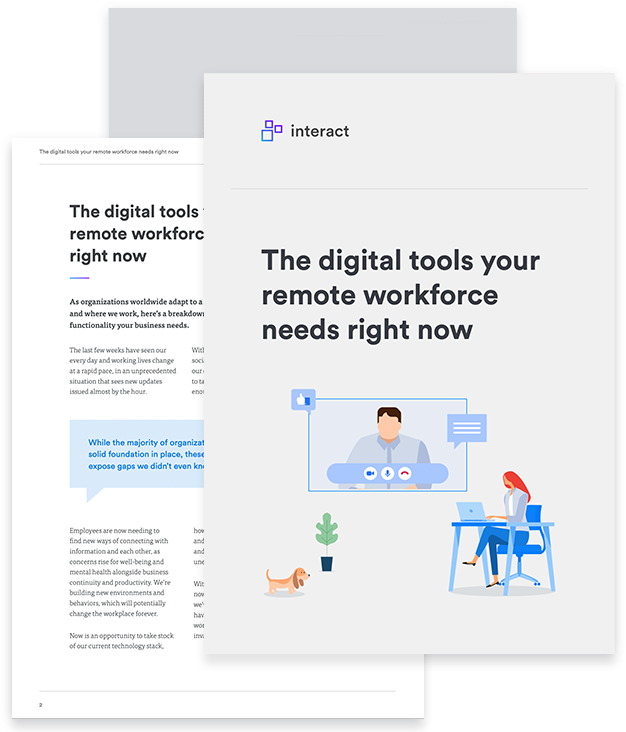Fitter, happier, more productive… Amid the disruption of the past few months, there have been many benefits for office employees. So, how can we bring the best parts of working in lockdown back to our traditional workplaces?
Since we last sat in the office with our colleagues, a lot has changed. The move to en masse remote working has exposed all the benefits and drawbacks of a completely remote workforce. This period will have a seismic impact on work going forwards, and by default, our lives, and business operations.
Traditional working life – the commute in, and the eight hours at our desks – worked, to an extent. It provides a routine, a chance to interact with colleagues, creating a physical manifestation of our organization. For employers, it sates the need for workers to be present, seen, and accountable. But it is a model that hasn’t changed in centuries – and with growing populations and expanding cities, it isn’t the most efficient use of time. The hours spent getting to the office and getting home, the race through rush hour, the many distractions throughout the day – the typical working day needs to be reconfigured. Traditional working life cuts into family time, the time to look after one’s health, to rest sufficiently. Many home workers have reported that this new way of remote working has given them increased autonomy, more motivation and higher rates of productivity. With this prolonged break from the rat race, it now feels like a change was well overdue.
The digital tools your remote workforce needs
In a few years, when we look back on this period, it will be easier to see the many little shifts and switches to our work that have taken place in such a short time frame. But as the restrictions slowly and gradually lift, we see a return to the office appear on the horizon. What form this return takes is as yet unclear, but there are several lessons home working has taught us, which will be prudent to take with us.
Remote working lessons
We’ve discussed whether this period has been the death knell for the traditional office. Although it’s by no means the end of the physical workplace, several improvements should be made to stay relevant and practical for both employees and the employer.
Flexibility

We’ve talked about it for years but the past few months has finally proved it: we don’t have to stay put in the office. Many roles are unaffected by flexible working, and if possible, we should bring the flexibility we’ve been experiencing over the past few months to mainstream working. This could see the working week become a combination of remote working and being in the office – or whatever works best for the individual. Many people’s domestic lives suffer by abiding by the 9 to 5 routine and a lengthy commute. Workers can still produce the same output without having to clock in at a prescribed time. Flexibility, whether the hours worked or the location where that work takes place, will make a hugely positive impact on countless workers, particularly those with dependents.
Certainly, for any working parents, it has been a testing time. But the idea of returning to the old ways doesn’t sit right. After being with our children 24/7 for so long, experiencing the highs and the lows, the switchback to us seeing them fleetingly in the morning, and when we get home at night seems outmoded. There is a way of balancing this, and perhaps going forwards, a more flexible approach to our work can allow this.
Lesson: Management should look at ways to implement a flexibility that benefits both employee and employer.
Time

Never have we been so aware of time than during lockdown. For those balancing homeschooling, the demands of children, and the lack of quiet time, we’ve have had to work in the most irregular schedules. This means that when we do get time to focus, we seize it with both hands. During lockdown, we’ve realized how precious a commodity time is and the juggling of other responsibilities and helped honed our time management skills.
Going back to the office, we may have the luxury of a dedicated workspace (with no children, pets or domestic chores to interrupt the flow), but we need to take our time management skills with us. Using our time wisely can improve productivity, making us happier and more efficient.
Lesson: Approach the working day more strategically. Whether you use the Pomodoro technique, a time management app, a daily task list, implement a routine to your working day with your team, and update your colleagues when to-do lists have been achieved.
The digital tools your remote workforce needs
Space

Working from home has seen us view our domestic space differently. If we are to consider remote working on a more permanent basis, it’s essential to dedicate a workspace in our homes. However, this isn’t always possible, and many workers have experienced some degree of claustrophobia padding from bed to coffee machine to desk every day for weeks on end. With work, we’ve certainly realized the value of space.
Yet in our offices, we usually stick to the one area, working amidst the chatter and ambient noise of our offices. But most offices offer different spaces for different types of work, and we can benefit from using the office space to its full advantage. If you need to focus, use any small room available. For small groups, relocate to discuss the project in hand. If you’re having lunch, make sure you break off from work completely. When you’ve been cooped up in your house for so long, take advantage of your office’s full range of space.
Lesson: As a team, sit down and discuss the various types of work you do, and what spaces are suitable for carrying out the work, whether it’s working from home, or using a pod for focus time.
The value of our digital tools

If ever there was an MVP in the move to en masse working from home, it’s our digital workplaces. They have helped us keep informed, up to date, allowed us to work regardless of location, share ideas, communicate, collaborate, and keep productivity rates more or less the same as pre-lockdown.
This period has crystallized how much we rely on software. In order to support us, we may have started using new services that were previously untested. Perhaps, we’ve modified the way we use existing tools. Whether its chat, video, screen sharing, company-wide meetings – it’s all been hugely fundamental in keeping us on track.
Lesson: Keeps apps and digital tools standardized, everyone should be using software approved by the company. Position your intranet as the center of your digital workplace to keep workers informed and connected.
We need an organizational structure

Moving to a remote working space can cause confusion and disruption, and feelings of isolation among dispersed employees can bring uncertainty over who to contact on a range of issues. At-home employees need a sense of the organization’s structure, and a workplace organogram is vital. A clear idea of whom to speak to and when is essential to overcoming the many challenges that working from home presents.
Lesson: Ensure all new employees are introduced to the structure of the organization during the onboarding process. If possible, set up quick meets with key figures in IT support, HR, and other areas so workers can put a face to a name.
Small groups work better

During working from home, the formation of sub-teams has evolved organically. These are employees who work closely with each other and communicate regularly. As such, they have a very clear idea of their parts within a project, despite being physically remote. While departments may gather together to talk about a project, these sub-groups are like self-governing states that ensure the deliverability and quality of various stages of the project.
Keeping teams down to small groups can also help with effective communication and a clear idea of responsibilities. Stronger bonds of trust evolve, and new starters will find it a lot easier integrating into smaller groups, particularly if organizations are still exercising the working from home option.
Lesson: Encourage the formation of smaller groups within the departmental structure and set up reporting lines to maintain communication. Rapport with the department as a whole is essential to keep the focus on collective goals and vision.
Communication

Without the daily interactions, the sharing of desks, and casual chat while making a hot drink, communication can suffer for remote workers. Without careful management, it can generally trigger issues further down the line, such as lower productivity and confusion. When colleagues do not physically see each other every day, it’s essential to revise how you communicate as a team. Group chats, one-to-ones, casual conversation are all integral to keeping the team close, minimizing negative feelings and keeping on track of tasks.
The experience of homeworking has shown that communication is at an all-time high. Through chat platforms and video calls, many professionals have noticed that they are communicating a lot more than they would in normal circumstances. Certainly, the stats from Zoom prove this, with ten million active users in December jump up to 300 million in April 2020. Office life may have meant that when employees physically see their colleagues, they feel less need to have meaningful and productive group conversations. When the element of distance is added, communication increases, because of that necessity to reach out.
Lesson: Whether home-based or in the office, make departmental or group meetings a daily event, even if it’s for a few minutes. It informs employees, increases accountability, and strengthens bonds between members.
On-premise is over

Many of us knew this already, but some organizations still using on-premise software quickly became unstuck in the move to en masse home working. For those businesses who had to make an exit from their workplaces, the infrastructure within that office was soon rendered inaccessible and redundant. This had created considerable problems in continuity and productivity, and workarounds were implemented to overcome these challenges.
Employees need software that is accessible wherever they are, whether they’re on their laptops at home or a cell phone on the go. Particularly during lockdown, there is a pressing need to open up unlimited access to the vast range of tools and applications needed to continue work. Cloud enables businesses to recreate the same conditions of an office at home. This period has been a startling wake-up call for many organizations to move all operations to a cloud-based equivalent immediately.
Lesson: Upgrade immediately and resign on-premise software to the scrapheap. The future of working needs agile, accessible, and secure cloud-based systems.
Empathy

It’s fair to say that the move to home-based operations was beset with challenges. With the closure of schools, health concerns, and lockdown anxiety, employees had to navigate a number of challenges in order to set the scene for a productive day at work. Businesses weren’t dealing with a few individual problems, but widespread disruption in not only the lives of their workforce, but also their own. Most employers approached the situation with empathy, allowing flexibility and understanding to be applied to workers’ circumstances.
This recognition of individual difficulties went a long way. With everyone aware that these were extraordinary circumstances, employees were thankful to be given the time and patience to organize themselves. The way organizations have handled themselves through the crisis will have a significant impact on staff retention levels, eNPS scoring, and overall engagement for the foreseeable future.
Lesson: Empathy shouldn’t stop after lockdown, but continue throughout the workplace to help workers find solutions to unique problems. Whether it’s organizing flexible working, taking time off or working from home permanently, an empathic approach fosters more open communication and more robust workplace culture.
Be open to change

Businesses are traditionally risk-averse, and when it comes to looking at new ways of working, not a lot has changed in decades. Of course, this safe approach was tipped on its head in March 2020. Employers could only hope that operations wouldn’t run into the ground as working from home was established. For most companies, it was business as usual, with the workforce stepping up and performing their duties as usual, (albeit in less than ideal circumstances). This has tested the workforce, but the majority have shown determination, faithfulness, hard work, and dedication. Any fears over working from home, or adopting flexible hours have been banished.
Lesson: Put enough trust in your employees and your digital tools, and change can be transformative. Be open to testing different methods and learning from things that don’t work. The workplace is continually evolving – by being open to change, businesses are staying ahead of the game.
Our society strongly favours a strong work mentality, and the hustle culture is stronger than ever. While the John Maynard Keynes vision of our generation working a 15-hour working week seems out of reach, there are significant changes we can make to improve the way we work right now.
If and when we return to our offices, there will be many health and safety measures put in place to prevent the old way of working for some time. But if we can combine the advantages of working from home with the benefits of office life, we will be making the much-needed changes that have been prevented for so long.



